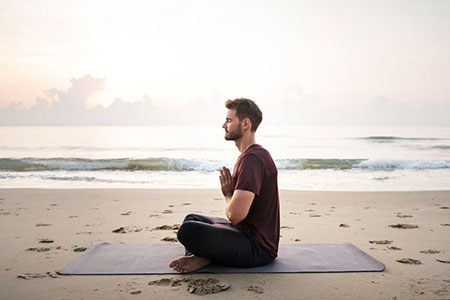Meditation Is For Everyone
 Meditation can easily be a part of your daily life. It is a simple spiritual practice. What is difficult is to change one’s habits.
Meditation can easily be a part of your daily life. It is a simple spiritual practice. What is difficult is to change one’s habits.
There are many variants of meditation, some of which you probably know and may have tried. If so, you may have discovered that the difficulties many of us face, when attempting to adopt meditation as a spiritual practice, are usually not related to the meditation itself. More often we are ‘fighting’ with our own minds. We are competing within, for the control, or the freedom of our mind.
Our enemies in this context are short-term rewards: leisure activities, such as watching TV, browsing social media, snacking, or anything that helps our neurons remain lazy. In these activities, attention is scattered and unfocused.
The mind thus learns to be ‘random.’ One could compare this state of mind to the behavior of a wild monkey. This restlessness has no practical purpose – it is just ‘noise.’ And it is happening all the time. We may feel we are actually doing something, but we are just passing the time.
Meditation puts a stop to this unnecessary mental activity. Although in meditation, one does not actively seek to stop thinking, one tries to generate the conditions in which thought is reduced, and the mind now merely observes whatever is happening: an idea, a feeling, a sensation. It is all just observed.
Meditation and concentration are the way to a life of serenity ~ Ram Dass
The mind likes its vices, even negative emotions and thoughts are attractive, they imply action. And action is fun for the mind. Spending time in silence is not fighting with every thought. Meditation implies an attitude of observing without judgment. Internal stillness means no friction, no effort is registered.
Silence is a widespread monastic practice – inner silence that is. It has many interesting effects on the person. It breaks mental routines and creates space for new perceptions and actions, that no longer come from the surface mind.
Beyond these effects, something exceptional happens when the constant flow of words and images in your mind stops – it stops shaping reality. The anthropologist Carlos Castaneda said that we sustain the world with our thoughts. Our mind structures reality according to certain concepts, allowing us to interact with familiarity in our environment. This distinctive flavor that our vision of the world has, of a whole that we generalize based on the portions that we know, has a feeling of ‘solidity’ or of ‘coherence’ that we project onto the world around us.
Everything that we find that cannot be linked within our reality, cannot have its place (a position in the referential framework of our knowledge), and remains as an island to which no bridge reaches. It just does not possess the necessary characteristics to be included in any of the possible assortments.
How does meditation help in such situations? It opens an entirely new path. It works directly with our intuition. Intuition is beyond this structure of understanding and can elaborate on information that we cannot fully comprehend rationally. This is a magical process, and one which guides many of the most successful people in the world.
Meditation is the secret of all growth in spiritual life and knowledge ~ James Allen
HOW TO MEDITATE
This is an experience that should only take a few minutes.
- Sit comfortably, on a chair or on the floor, turn off any distractions.
- Let your hands rest on your lap and keep your back straight.
- Lean forward, backward, and sideways a little bit to find a natural equilibrium.
- Keep your eyes open, looking at the floor three feet in front of you. Make sure you are not making any effort with your eyes; they should be relaxed. Do not try to fix them on a point.
- Pay attention to your breath, and without changing it in any way, try to perceive the moment in which the inhaling stops and the exhaling begins. And vice-versa: become aware of the exhaling ending, and feel when the air starts coming in again.
- You can do this meditation for about five to ten minutes and extend it after several days. Twenty minutes of meditation in the morning and another twenty in the afternoon is considered a good practice that can be maintained over time.
Remember that the way to clear the mind is not by force. Having an open attitude will bring peace. Whatever crosses through your mind, while practicing meditation, let it remain, and offer no comment, no like, or dislike. You will see the results very soon.
|
|

Leave a Reply